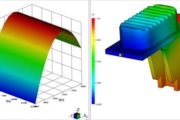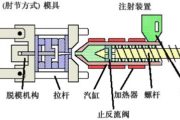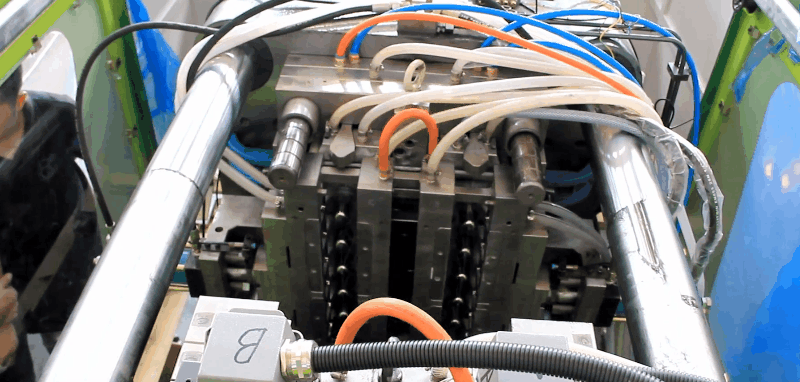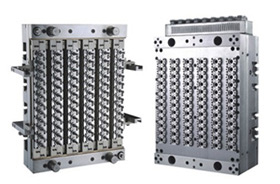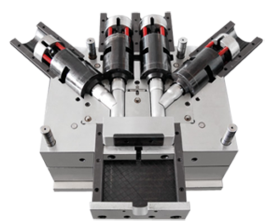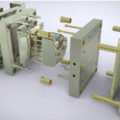
Plastic Injection Molding Process Parameters have 5 big parts: Injection Pressure,Injection Time,Injection temperature,Dwell Pressure and Dwell Time, Dwell Pressure and Dwell Time. They are all very important setting for injection molding engineers.
1. Injection Pressure
Injection pressure is provided by the hydraulic system of the injection molding system. The pressure of the hydraulic cylinder is transmitted to the plastic melt through the screw of the injection molding machine. Under the pressure push, the plastic melt enters the vertical flow path of the mold through the nozzle of the injection molding machine (also the mainstream channel for some molds), the main flow channel, and the split flow. The process, through the gate into the mold cavity, is the injection molding process, or the filling process. The pressure is present to overcome the resistance during the melt flow, or conversely, the resistance present during the flow process needs to be offset by the pressure of the injection molding machine to ensure a smooth filling process.
During the injection molding process, the pressure at the nozzle of the injection molding machine is highest to overcome the flow resistance throughout the melt. Thereafter, the pressure gradually decreases toward the front end of the melt along the flow length. If the internal exhaust of the cavity is good, the final pressure at the front end of the melt is atmospheric pressure.
There are many factors affecting the melt filling pressure. There are three categories in general:
(1) material factors, such as the plastic type and viscosity of the plastic, etc
(2) structural factors, such as the type, number and location of the casting system, and the cavity of the mold. Shape and thickness of the product, etc.;
(3) Process elements of molding.
2. Injection Time
The injection time mentioned here refers to the time required for the plastic melt to fill the cavity, and does not include the auxiliary time such as opening and closing of the mold. Although the injection time is short and the effect on the molding cycle is small, the adjustment of the injection time has a great effect on the pressure control of the gate, runner and cavity. Proper injection time helps the ideal filling of the melt and is very important for improving the surface quality of the product and reducing dimensional tolerances.
The injection time is much lower than the cooling time, which is about 1/10~1/15 of the cooling time. This rule can be used as the basis for predicting the molding time of the plastic parts. In the case of mold flow analysis, the injection time in the analysis results is equal to the injection time set in the process conditions only when the melt is completely driven by the screw rotation to fill the cavity. If the holding pressure of the screw occurs before the cavity is filled, the analysis result will be greater than the setting of the process conditions.
3. Injection temperature
Injection temperature is an important factor affecting injection pressure. The injection molding machine barrel has 5 to 6 heating sections, each of which has its own suitable processing temperature (for detailed processing temperatures, please refer to the data provided by the material supplier). The injection temperature must be controlled within a certain range. The temperature is too low, the melt plasticization is poor, affecting the quality of the molded parts, increasing the difficulty of the process; the temperature is too high, and the raw materials are easily decomposed. In the actual injection molding process, the injection temperature is often higher than the barrel temperature, and the higher values are related to the injection rate and material properties, up to 30 °C. This is caused by the high heat generated by the shearing of the melt as it passes through the injection port. In the mold flow analysis, the difference can be compensated in two ways, one is to try to measure the temperature of the melt-to-air injection molding, and the other is to include the nozzle in the modeling.
4. Dwell Pressure and Dwell Time
At the end of the injection molding process, the screw stops rotating and only advances, at which point the injection molding enters the packing phase. During the pressure keeping process, the nozzle of the injection molding machine continuously feeds the cavity to fill the volume vacated due to the shrinkage of the workpiece. If the cavity is filled without holding pressure, the part will shrink by about 25%, especially if the tendon is too large to form a shrinkage mark. The holding pressure is generally about 85% of the maximum filling pressure, of course, it should be determined according to the actual situation.
5. Back Pressure
Back pressure refers to the pressure that the screw needs to overcome when reversing the backstock. The use of high back pressure facilitates the dispersion of the colorant and the melting of the plastic, but at the same time prolongs the screw retracting time, reduces the length of the plastic fiber, and increases the pressure of the injection molding machine, so the back pressure should be lower, generally not exceeding the injection molding. 20% of the pressure. When injection molding foam, the back pressure should be higher than the gas shape, otherwise the screw will be pushed out of the barrel. Some injection molding machines can program the back pressure to compensate for the reduction in screw length during melting, which reduces input heat and reduces temperature. However, since the result of this change is difficult to estimate, it is not easy to adjust the machine accordingly.
